Abstract
The purpose of this research is to examine the extent to which the training and skill development programmes can help the employers and policy-makers to fight against economic crisis. To do so, this paper will illustrate the theoretical framework of knowledge and skill development, job-related training programmes in the international labour market, the position of unskilled labour force in financial downturn, and the relationship between skill development and productivity. However, this paper will focus on the importance of skill development programmes, particularly vocational training courses and initiatives of the governments of different countries to build skilled labour force to address the immediate challenges and to attain competitive advantage in the post recessionary economy.
Introduction
In September 2008, the credit crash in the US mortgage market and collapse of Lehman Brothers generated the GFC that had spread out all over the world through international banking system; the impact of GFC was so serious that the global economy could not overcome the recessionary impact yet in 2013. Different fiscal and monitory tools including bailout has failed to stabilise the global economy; under such a background, the UK government have addressed a skill development strategy to encounter the recessionary impact. This research has aimed to investigate to what extent the training and skill development could assist to fight against economic downturn.
International Skill Position of Different Countries
About 47% of the total labour force of Canada was highly skilled, and 40.5% employees of Japan was highly skilled in 2009 and these two countries have long-term plan to hold the present position by creating 60.2% and 59.9% high qualified labour within 2020; however, the following table shows level of skills –
Table 1: Skilled labour forces. Source: Rake (49).
The developed countries like Japan, the USA, Germany, and France have provided special attention to train the leaders of the companies because skilled management team can manage the companies and co-workers more effectively. The managers of the UK are less skilled, which can become serious challenge for this country in the competitive world; however, the next figure demonstrates the position of five developed countries in this regard –

UKCES (10) stated that the UK, only 600 managers are skilled among 1800 managers of the public sectors and it indicates poor management capacity in terms of international indicators of qualifications in the global financial crisis. As a result, the policy makers focus on the implementation of the long-term plans to overcome post recessionary impact and compete with international markets, for instance, Vocational Qualification Reform Programme (VQRP), ambition 2020 and so on (Bewick 10). At the same time, the policy makers have identified several concurrent alarming issues in the global context, such as –
Skills mismatches between the skills available and skills required constrain enterprises from being proficient to meet market demands, scopes or goals; however, the following figure shows these issues –
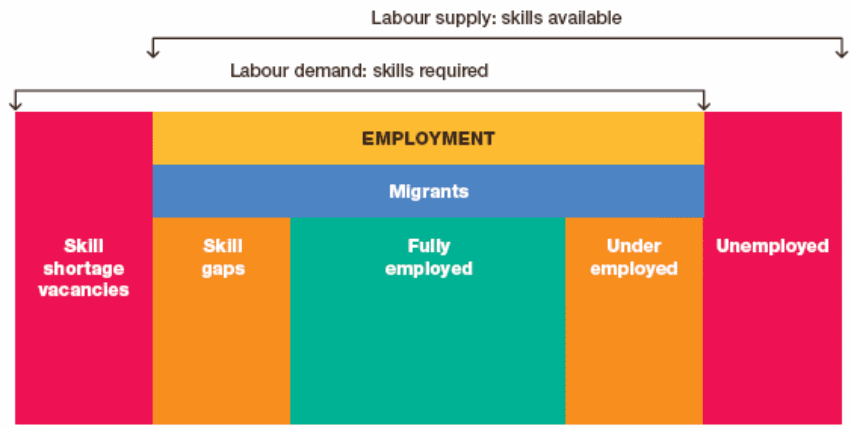
Mason & Kate (5) stated that the developing countries mainly faced problem related with skill shortages.
Active Labour Market Policy
Meager (3) mentioned that the wider part of the literature of skills development integrated with the labour market policies are categories in two like ‘Active’ that urge for market re-engineering and ‘Passive’ from advocates for ‘alternative earnings’ during the unemployment that could be ensured through ‘unemployment insurance’ or special financial support. The Active labor market policy (ALMP) evidenced in the European countries due to war crisis, it bring comparative balance in the labour market policy through implication of both the active and passive instruments that generated remarkable mobility in the market to stabilise at right direction. On the other hand, some literature kept their efforts to analyse ALMP from the explanation of supply to meet the labour market demand, such thoughts align with following attributes –
- Training Scheme: – This module of ALMPs integrated option for general and vocational skills arguing that it increases the prospect having fresh entry for the unemployed
- Job Information & Brokerage: – This scheme arraigned to introduce a one point service providing for the job seekers or both public and public sector and they would be able to know all information related to job they would like to apply, the brokers have the opportunity primary selection and pace applicants data to the employers through online;
- Guidance and Advice Centre: – Such service providers would provide commitment that is more realistic for the job seekers integrating necessary support for skill development including required motivation
- Scope for Sanctions and incentives: – This scheme designed for the complete jobless to provide special support and benefits for participating in the obligatory training programme that encourages financial incentives linking with their skills; there are some other supportive programmes that increase the interest of individuals to participate in training.
Skills Development & Productivity
There are diverse opinions to defining the terminology ‘’skills development’’, DFID (4) clarified that it is a continuous process to integrating technical and vocational learning as a supply-led scheme that deliver enhanced productivity as an unavoidable learning outcome regardless to the time space and or person who provided it. The attainment of skills specifies the needs of the workplace, whether it is generic or technically, the modification of emphasis shifts the accord between training scheme as well as labour market by granting wider variety of learning environment, quite flexible learning detail required by the individual with obligation of the stakeholders. It includes a broader area including competence of capabilities, learners age group, features of the industry where the employees intend to serve, minimum qualification to attain in the training integrating with the concurrent business needs as well as future prospect.
The World Bank (23) presented a complete model of skill development framework from the childhood learning to market placement training and urged that it is essential to recognise the rights of every employee for training to address the productive innovation of the industry where he works. It is natural to go for training would hamper the current production by that worker, but the flexibility for human resource development would ultimately generate enhanced productivity that would directly assist to boost revenue. On the other hand, more flexibility to the employees would assist to generate mobility within the labour market and the employee would get better opportunity for the superior match of his skills that may assist greater mobility in the labour, but without social protection, employees cannot enjoy such facilities. The establishment of excellent basic education, employability skills, job centred qualification, supportive entrepreneurship, continuous improvement, creativity, scope for accurate job matching and mobility, social system systems provided by the state or unemployment insurance could ensure the implication of this model prescribed by the World Bank (1-36)
Conceptual Framework of Training & Skills
Engestrom (11) mentioned that the most common public reception about learning is that the acceptance and memorisation of realistic knowledge, repeated application of that that knowledge provides proficiency to perform same task continually with less effort and in correct way that is called skills. The learning outcomes provide fresh attitudes other than before learning and changes the behavioural models of the learners pedestal on the emotional attitude of the learner along with the surrounding social experience that he interacts regularly where the conventional framework of teaching, learning and skills development composed with following attributes-
- The general insights on ‘learning of knowledge’ and ‘learning of skills’ are totally different, but strongly interdependent to each other;
- The ‘learning of knowledge’ organised with an assortment of steady hypothesis structured with expedient truths with readymade facts and features without any linkage to the direct action or a way from activity;
- The ‘learning of skills’ are achieved through practical implication of learned knowledge like a vehicle performance where is knowledge and thought are not an element of the performance, but core competence of the diver;
- The attitude of learning is to gathering knowledge while the attitude of skills is to generate positive productivity;
- In the paradigms of training, learning, and skills development, the human brain is the storeroom to preserve knowledge, more facts and features an individual could memorise, it is predicted that more he learnt;
- From the trainee’s viewpoint a learner is considered a point of external pressure with his individual awareness, willingness to gain personal objectives from the learning scheme; as an individual the learner takes apart himself from his belonging social ties, but engage his effort for practice;
- The learning outcomes deliver particular knowledge from the memory within the implication of an action that generates better performance with smooth experiences where the implication significant make-up of knowledge engaged for greater motivation.
Engestrom (20) pointed out that the domain of productive learning could effortlessly evidence at the society where as an interested problem-solver an individual is willing to discover the justification and solution of a problem, while the learner engages to utilise different tools like books guidance of other people experienced in the same area. In this assortment the knowledge resources act as learning instruments where learning occurs in a circular motion among the learners, instrument, and learning objectives, the structure of learning illustrated as a part of regular learning below –
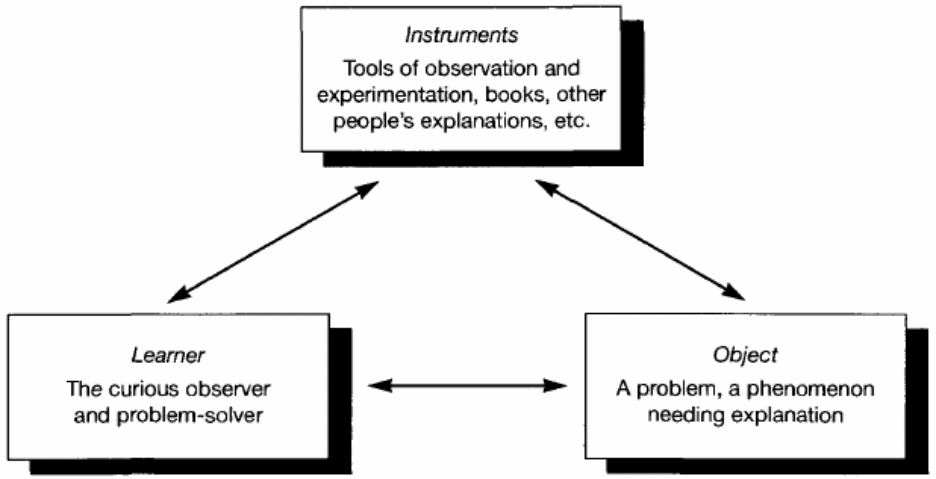
Margerison & McCann (14) pointed out that companies involved with teamwork necessarily required to developing communication skills along with problem solving efficiencies while any five types of skills are essentially required for this purpose referred as below –
Integrating above five skills, Margerison & McCann (15) presented the model of communication diamond as follows-
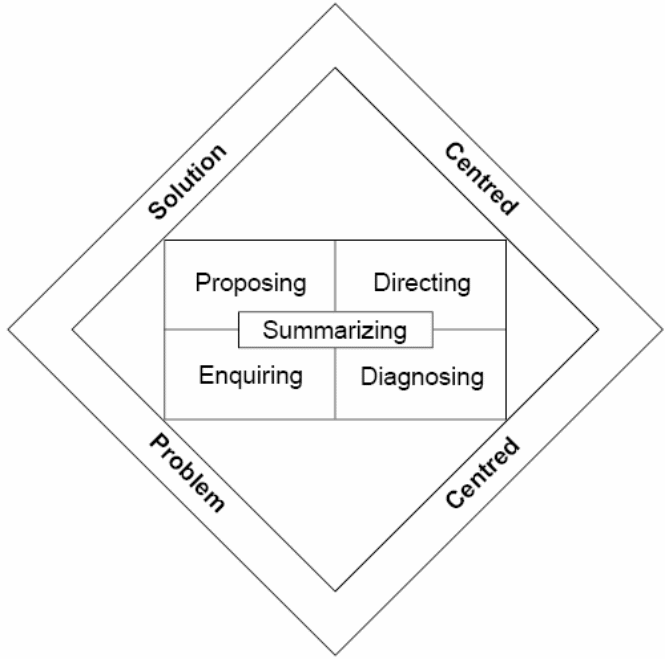
This model illustrates that five skills are strongly interlinked to focus on an individual’s skills that emphasis on problem solving attributes aimed to provide exact justification with complete solution where the enquiring and diagnosing skills aligned with problem centred zone, proposing and directing skills lie at the solution centred area and the summarizing skills would generate bridge with two area.
Changing Dynamics of Training
Hannon (1) pointed out that the concurrent school reformation initiatives has failed to initiate appropriate training to produce right skills that is required by the real life business, the perfection offered by the institutions are very insufficient to meet the challenges that the organisations are facing from economic downturn. The schools do not prepare the youth people how to sustain under the new challenge of recessionary economy or how they encounter with crisis, the knowledge and skills that they are developing contains huge gaps with the real life scenario, mostly they are contrary to the organisational learning that the business communities are looking for. The role of schools looks like ‘quasi-custodial factories’ where the skills required for business success inherited with leadership, learning, and teamwork; such practices are remarkably absent in the school curriculum and teaching process, individual innovation or collective creativity looks very poor in the institutional atmosphere (Leiba 709). The business communities do not desire that the schools would build up the young people ready to work at once, but it is expected that the schools should provide skills at a basic level that would assist the new employees to motivate them in accordance with the organisational needs.
Hannon (3) added that the changing dynamics of socioeconomic reality of economic downturn, it is required to introduce a model of driving change in the process and quality of the training and developing skills to face the challenge of twenty-first century with social innovation, technology integration along with inspiration that would generate a Learning Eco-Systems. At the same time, teaching attitude of the schools needed to be more flexible for the learners, learners who have the IT facilities; web-enabled learning materials should be delivered to them through social networking, while the less adventurous student needed to take in special care from the social responsibility of the institutions.
Mills, Bowman & Ranshaw (5) argued that the engagement in training are essentially conducted with a standard set of skills set out the national authority of a country with particular flexibility and significance towards vocational education and training approach designed and developed on the basis of the local industry needs. Johnson, Jim & Linda (4) mentioned that in the UK, the National Skills Academies were established in 2006, the objectives of the NSAs were to formulate the standards to the skills development courses integrating employee’s representation in board and their required skills. NSAs already formulated their regional institution to generate the training courses which are more prior to the regional employees in order to fill up gaps of the existing employees and to the national standard; at the same time, it conducts effectual negotiation among the training service providers to employees to fix up an affordable cost for training.
Views of Strategic HRD on Training and Skill Development
Garavan (12) explored that the resource-based analysis always emphasis on the in-house knowledge and skill to attain competitive advantage for the organisational development, where increasing investment for training and skills development provides major proficiency to generate most challenging human capital. Thus, the value of that trained employees rise to a hierarchy where an assortment of unique skills and capabilities strengthen the competitive advantages in comparison to the rivalry organisations in the market, the way in which organisations comply with human resource development. Obviously, every organisation has its own strategy for HRD; from the resource-based theories of human capital development, it contributes to gain knowledge and skill appropriate to address particular needs of the organisation to attain strategic goals and long-term vision of that business. The amalgamation of diverse knowledge elements and multi-level skills along with the enhanced capabilities of the employees provide sustainable competitive advantage that the organisations enjoy unparallel performance by boosting new area of revenue generation where the trained employees get greater opportunities to demonstrate their self-competencies.
From the strategic approach of HRD on training and skill development, the organisational learning brings improved and superior performance that generates mobility and change by introducing internal training, job analysis, and leadership growth coordinating with the management by adopting competency framework. According to the SHRD approach, the sphere of organisational learning has intended to introduce smooth progress of learning culture within the organisation where learning environment ensures open entry of the employees to particular training programme confirming free flow of information within the organisation aimed to cultural shifts and career development scheme. The training and skill development programme of the organisation would always be extremely linked with organisational dynamics, particularly flexible to the employees including openness to the learning and proactive to training that generate three domains of HRD implication such as transactional approach, traditional loom, along with transformational framework as a means of SHRD implication.
Emergence to Invest for Skills Development Program
In different countries, there are diverse skills development program, but the fundamental goal of them are mostly similar and that is to generate deferential working force with advanced knowledge and experience achieved through a particular period of training or participating in several months course or diploma. The trained employees are supposed to get higher ranking of salaries and benefits than the ordinary workers get, the enhanced financial benefits of the trained employee would facilitates him to pass sound livelihood under the concurrent recessionary economy. On the other hand, the improved skills of the employees would positively generate smooth and timely production then before, while workers efficiency development would develop at all levels of national economy, the foreign direct investment would be inspired in that country. Moreover, the promotion of the trained employees at a superior level would generate new vacancies at entry level that ultimately create new employment opportunities in the economy. Simultaneously, the enhanced productivity of the trained employees would also boost the production quality and quantity the lead the economy towards export market for foreign currency earning; this is the way that training and skills development would contribute the economy for wealth generation.
Private and Public Partnership for Skills Development
HM Treasury (9) explored that the UK government strongly upholds perception that skills development in the public sector, the private sector plays an indispensable role where it would requires voluntary or involuntary partnership, and joint venture with nongovernmental organisations or commercial providers. Under PPP contracts, government would procure support and services from the private entrepreneurs through usual procurement process that government follows, here the associated risk, tenure and effectiveness of the performance goes to both sector as PPP has established with the concept of working together by sharing risk. In the traditional public procurement, public bodies carry out the possession related risks and the private sector operational risks related to quality, but the mode of PPP for public sector skills development could be organised joint tenure and proportionate risk sharing through long-term contract and even outsourcing. PPP provides additional hope of success in many countries, to ensure right use on public money it required major reformation in the area of transparency, rate of return, features of liabilities with accounting process to ensure right use of public resources including the materialisation of PFI to match with the changes of global financial market.
Dunbar (3) argued that the most effectual skills development initiative would incorporate soft and technical skills required for ‘on the job’ and ‘off the job’ both types of candidates assessed and identified from the casual survey of the labour market conducted by the working groups. The training programme would generate employment opportunity for the unemployed, for the employed it facilitate to upgrade his existing position to the next level, at the same time, interns from the academia would achieve their practicable experience for their future competition for the job market or to get placement. Here, the trainers from the private sector play most precious role than the public trainers in context of cost saving, effectiveness and more dare to encounter with new challenges with strapping administrative capabilities cost-effective process of fund management to ensure higher return on the investment for the training programme. Public sector trainers have the more skills at public administration, close connection with the different department, free flow of information and strong fund mobilisation capabilities emergence to implementing any new project while trainers from both the sectors have their own prospect and limitation.
New Umbrella Standpoint of Skills
O’Donnell & Garavan (1) mentioned that the skill is sometimes inborn otherwise, an acquired attributes of learning outcomes those are organised by the essential role of professional trainer, who guides and facilitates the learner to a particular progression. The development of skills generates capabilities of taking challenge, mitigating conflict and ability for critical analysis of the society along with strong attitude for self-assessment based on a cognitive inspection of learning and psychological response. To attain the simple skills it required better learning with enhanced flexibility with appropriate understanding to the principles of learning where the primary responsibility of the trainer is to make certain that an effectual learning process has integrated by which the learner would capable to reach at the expertise level that he desired. The underlying principles of learning to attain skills would provide further experience and awareness to growth self-development during the reflection of the method intrinsic to the learning process that provides amplified intelligence of delicate control, empowerment along with autonomy for the trainer, thus the role of trainer is significantly challenging.
Every skill for social performance, physical feat, or for mental excellence has different process to attain, but there are some common attributes these are the process has to learn with particular objective, set up target and put into practice for chronological sequences with exact ordering of coordination. The skills process involves with a physiological phase that is essential to deliver skilled performance, the human psychology illustrated that human brain has diverse strengths for information processing that generates different types of constraints for different performer where the skills of an individual are measured through a comparison with an unskilled person. Thus, the skilled individuals are the disciplinary expert on a particular area who has significant speciality in that field to adopt his knowledge correctly to any new situations with multiple Intelligences representing corresponding skills that is competent to develop at any age through learning assistance from the trainer or even self development (O’Donnell & Garavan 2).
Training and Skills Development under Recessionary Economy
Cheese (3) explored that impact of unsolicited economic downturn has seriously hampered the usual business life where the organisations are demonstrating their reluctant mode of nourishing their talent management, many organisations are cutting job as a part of cost reduction and continuing their business with less skills of the key workforces. Due to job cutting, many skilled and competent employees are losing their present employment and the organisations are striving with low paid inefficient workforce that leading the business towards an uncertain direction and need for immediate attention to establish training and skills development programme (Kucherov & Zavyalova 87). The most concurrent researches in the UK illustrated that business communities are going through a dangerous drive with unskilled human resource with lack of employees’ engagement where middle level managers have no job satisfaction; the skilled employees are moving towards to a better job market or turning unemployed (Rothwell 88).
The history of recessionary economy illustrated that the crisis in the talent management may not continue for a long time, the economic downturn of eighties and nineties evidenced that mobility of human resource remarkably increased immediately after the recession, but the concurrent downturn is significantly different and failed to bring economic by last four years. Under such circumstances, the public sector and the responsible private sector are keeping their efforts to retaining the skilled employees and attracting new talents with greater flexibility as well as offering progressively more diversity in terms of socioeconomic and ecological engagements (Lazarova & Cerdin 407).
The vulnerable economic condition illustrates that to retaining and attracting the business talents essentially demands rehabilitated focus and offering vigour value proposition for the employee with enhanced flexibility to draw more and more diverse talents matching with business model of the organisation (Schmidt 4). Some of the theoretician arguing that integration of the Information Technology could be another flexibility tool for business communities to conduct training and skill development online while employees could perform most of their duties without attending at office through web based engagement (Caligiuri & Tarique 336). To provide such extent of employees flexibilities, the organisation needs to engage particularly with training and skill development with greater importance where the employees would learn new strategy to encounter with the recessionary economy and uphold the organisational strategy to attaining long-term vision.
UK Governmental Initiatives for Skills Development
TUS (3) pointed out that the UK governmental policy to emphasis on skills development of the employees is a very appropriate step to fight against the concurrent recessionary economy where the employees are in continuous threats to lose their exiting job. It vision 2020 explored the determination to establish the country upon a strong base of ‘’World-class Skills” that would contribute to protect themselves from the panic of job cut and provide further opportunity to survive at the post recessionary economy. The package offered by the government to improve the job market vulnerability through training and skills development is quite feasible from the social priorities and economic viability as it has generated new hope for recovery through rising sectors along the Green economy.
SSCs and RDAs including other governmental agencies are working together to implementing the skills strategy through T2G grant that already allocated £258 million for the sectors encountering with joblessness and planning to allocate further £350 million for the state financed construction projects and SME sector where workers are trainees and distressed by recessionary economy. At the same time, government introduced JCP to provide quick response to the fresh starters at their entry jobs with appropriate training addressed by the industries that have vacancies, this program generates hope for the unemployed to get new entry and sustain with competence gained from training and skills development. The governmental steps to training and skills development has integrated the employees at risk of job loss where employees union has a wider role to ensure more participation and motivation of the employees to attain at the training program with special emphasis to the industry’s needs where they are interested to engage for future job prospect.
Importance of Vocational Training
Kasipar, Mac & Se-Yung (11) stated that vocational training is different from other training programs because it should require practical knowledge related with real needs. The government of Vietnam seemed that above-mentioned training courses play vital role in case of poverty reduction while it closely linked with production; therefore, the Ministry of Labour, Invalids, and Social Affairs (MLISA) is responsible to supervise vocational training in the country. The government has established about 262 vocational schools, almost 600 vocational centres, over 800 jobs centres and over 200 colleges to serve business purpose and met the demands of labour markets; however, the following figure shows management –
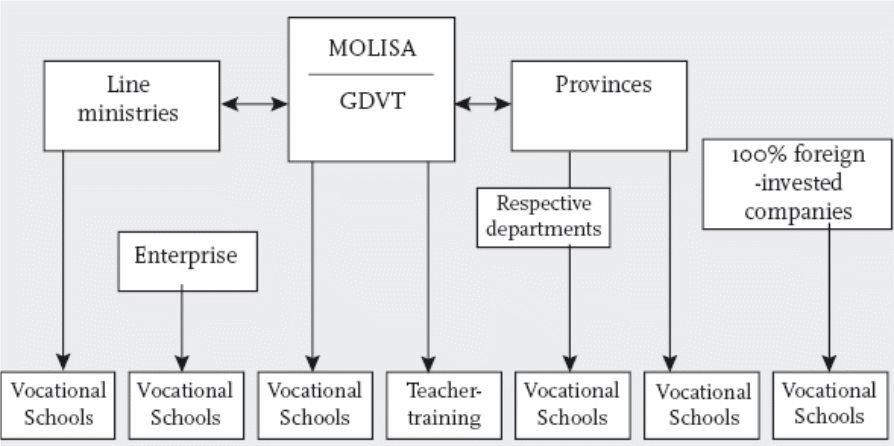
At the same time, it had about 1.34 million students and 2.6 million full-time trainees in 2006; however, trained employees made up 20.2% of the total workforce and annual average growth rate was 6.5% (Kasipar, Mac & Se-Yung 12). This initiative increased economic growth rates (GDP per capita amplified by 50%) and sped up industrialization and modernization procedure; however, the following figure shows employees in different sectors –

Kasipar, Mac & Se-Yung (12) further stated that developing countries have already driven on the industrialization process within the next seven years; for instance, Vietnam had about 240,000 enterprises employing 11 million workers (near 3 million engaged in the SMEs) and they play significant role of the national economy. SMEs particularly foreign invested companies need more skilled labours as the production depends on the advanced technology and use of knowledge; however, SMEs earned more than 25% to 40% of the total GDP (Kasipar, Mac & Se-Yung 14).
At the same time, Quanquan (69) stated that the government of China concentrates on the continuous development in practical work-based training as it tries to prepare students for employment and to adapt to the shifting construction of the Chinese economy. In addition, Quanquan (69) stated that the government of this country introduced suitable plans and concentrated on reforms to meet the needs of industrialisation. Therefore, in 2002, the State Council concentrated on the vocational training programs as it needs available skilled labour both in rural and urban areas to enhance the development of the industrial sector.
On the other hand, the UK Commission for Employment and Skills reported that the people of this country have taken some measures, but this country achieved relatively low score among the EU and other OECD countries to make popular vocational training programs. The government has increased remuneration for the academic and vocational training holders considering economic value of the qualification; however, the following table demonstrates the percentage of labour getting some form of vocational training –
Table 2: The percentage of workers getting vocational training. Source: UKCES (86).
Labour Market and Global Recession of 2007–2009
According to the report of the US bureau of labour statistics (1), there were at least ten recessions within the fiscal year 1948 to 2012. However, global economy experienced recent recession in the last month of 2007, which continued for two years though many countries still face post recessionary impact (the US bureau of labour statistics 1). Here, it is important to mention that there were different effects on different industries and employees, for example, employment rate declined by 13% to 10% in the construction and manufacturing industries in the recent recession whereas employment rate increased by 3.9% in the financial activities (the US bureau of labour statistics 9). According to the following figure, employment rate also amplified by 5% in the education and health sectors –
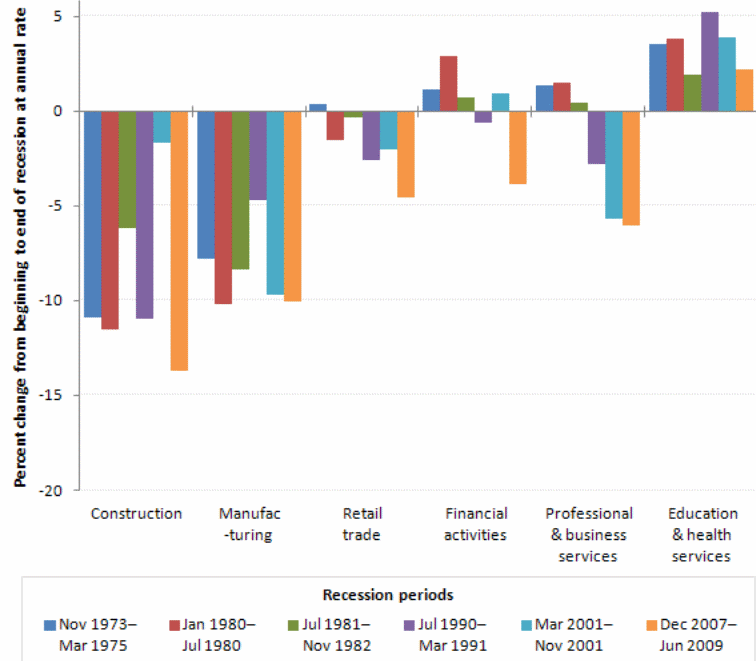
Job Related Training Programme in the Recessionary Economy
At the time of global financial crisis, the employers tried to reduce costs for the training program since they have experienced either huge loses or gain minimal profits (Mason & & Kate 36). However, employers have taken different initiative to develop skills considering their needs, for instance, the employers concentrated more on the short-term skilled development program in the recessionary period of 1990s. However, the rationale behind to take such decision was reduction of sales and production worldwide while employers aimed to manufacture goods with skilled labour as few expert workers could maximise production with maintaining quality (Mason & & Kate 2010, p.36). According to the analysis of CIPD (5), business profits along with investment reduced disproportionately in the fiscal year 2008/09 and it was very common scenario in the recessionary economy. As a result, multinational companies and small and medium enterprises reduced their budget for training programme to decrease spending to continue business in the industry; however, this perspective was varies for different industries.
In this context, many researchers including Mason & & Kate (37) gave importance on the job related training program. Most of the developed countries, for instance, the UK, the USA, Germany, Netherlands, Japan, and other countries have already concentrated on the job related training programmes to experience escalation in the job sector despite unfavourable economic environment. Therefore, the government of the UK had prepared skill development plan known as Ambition 2020 in order to overcome unparalleled and unpredictable challenges (Rake 3). The UK Commission for Employment and Skills stated that Ambition 2020 would work to secure economic renewal where employment is declining and unemployment is mounting (Rake 6). The aim of this plan was to create specialist, highly skill, and dynamic workforce for the future development of the people driven economy; in addition, this plan would raise the ambition and objective of the people to attain new skills (Rake 6). However, the purpose of the proposed plan was to ensure job opportunities for the skilled labour because they can lose their present job due to recessionary effect on the corporation.
On the other hand, the employers have limitation in understanding the importance of skilled labour to increase productivity for which they were not interested in allocate sufficient fund to train the unskilled workers. Therefore, the employers were bound to carry on production system with unskilled labour in many cases; however, however, the subsequent figure demonstrates data for the workers under 16 to 64 age limit –
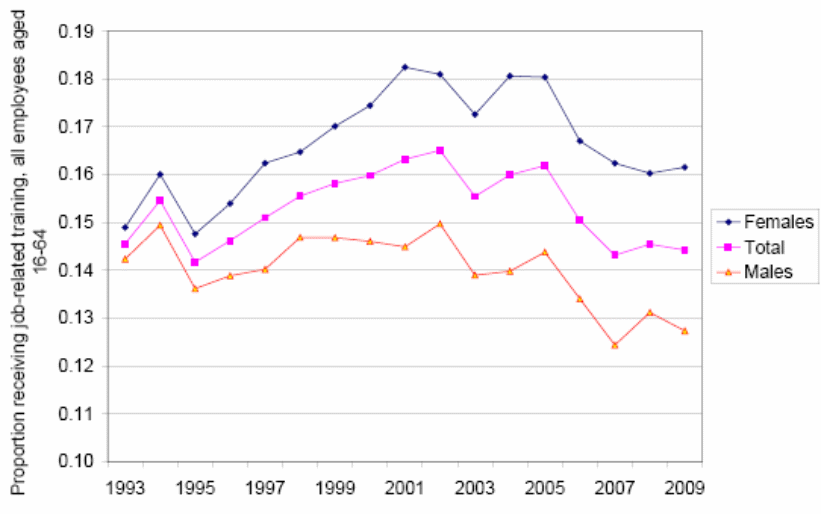
Recommendation
- The employees of Japan are too experienced, but they need to participate in more training programs to overcome barriers in the recessionary economy;
- The policy-maker should develop influential monitoring committee to carry on training and skill programmes;
- Moreover, it is important to impose duty on the committees to submit quarterly report to assess the success of different programmes.
- There are many developing countries in the world where skilled labour are available at minimal wages, but they do not get job according to their skills; therefore, it is important to employers of the developed countries to recruit more labour from developing countries like India, Bangladesh and China. In this circumstance, the employers have to provide sufficient training to the employees in order to remove communication problems and minimise the risk of staff turnover;
- In the era of information technology, the policy makers should concentrate on the use of computer skills and level of sophistication;
- At present, the job market is uncertain position all over the world; therefore, the policy makers of the developing countries should concentrate on the vocational training programs. In addition, it should build vocational training networks in the rural and urban areas to raise aspirations and awareness of the people and to implement industrialize and modernize plans;
- Moreover, the policy makers should make simpler the whole training programs and process, such as, demand-led system to attract the workers who come from different cultural background to enhance skills;
- It should focus on the gap between part-time and full-time employees, and the long-term refuse in workers’ task discretion, distinction between male and female workers, arrange integrated marketing campaign to aware policy makers and employers on the importance of training to boost productivity, need to address different skills requirement for the part-time and full-time employees,
Conclusion
From the above discussion, it can be said that employers have reduced budget for the training programme, but the government of developed countries like Japan, Czech Republic, Canada, and the USA have taken long-term measures to increase productivity, employment rate, and skills to unprecedented levels. This paper has identified numerous problems and provided possible solution related with skill development programmes since at least ten recessions hit the global economy in this century when unskilled labour force lost their job, and employers failed to increase sales revenue.
Works Cited
Bewick, Tom. UK employment and skills in a global recession, 2009. Web.
Caligiuri, Paula. & Tarique, Ibraiz. “Predicting effectiveness in global leadership activities.” Journal of World Business. 44(3): 336. 2009. Web.
Cheese, Peter. “Talent management for a new era: what we have learned from the recession and what we need to focus on next.” Human Resource Management International Digest. 18.3 (2010): 2-10. Print.
DFID. Engaging the Private Sector in Skills Development, 2010. Web.
Dunbar, Muriel. Engaging the Private Sector In Skills Development. 2013. Web.
Engestrom, Yrjö. Training for change: New approach to instruction and learning in working. Geneva: International Labour Organization 1994. Print.
Garavan, Thomas. “A Strategic Perspective on Human Resource Development.” Advances in Developing Human Resources. 9(1): (11-30). 2007. Web.
Hannon, Valerie. Only Connect! A new paradigm for learning innovation in the 21st century. 2009. Web.
HM Treasury. A new approach to public private partnerships. 2012. Web.
Johnson, Claire. Jim Hillage & Linda Miller.Evaluation of National Skills Academies. 2011. Web.
Kasipar, Chana, Mac Van & Se-Yung LIM. Linking Vocational Training with the Enterprises – Asian Perspectives.2012. Web.
Kucherov, Dmitry & Zavyalova, Elena. “HRD practices and talent management in the companies with the employer brand.” European Journal of Training and Development. 36(1): 86-104. 2012. Web.
Lazarova, Mila & Cerdin, Jean. “Revisiting repatriation concerns: organizational support versus career and contextual influences.” Journal of International Business Studies. 38(3): 404-429. 2007. Web.
Leiba O’Sullivan. “The distinction between stable and dynamic cross-cultural competencies: implications for expatriate trainability.” Journal of International Business Studies. 30(4): 709-725. 1999. Web.
Margerison, Charles & McCann, Dick. “Five skills to improve performance.” Team Performance Management: An International Journal. 2(1):14-16. 1996. Web.
Mason, Geoff & Kate Bishop. Adult Training, Skills Updating and Recession in the UK: The Implications for Competitiveness and Social Inclusion. 2010. Web.
Meager, Nigel. The Role of Training and Skills Development in Active Labour Market Policies. 2010. Web.
Mills, John. Bowman Kaye. & Ranshaw Danielle. Workforce skills development and engagement in training through skill sets: literature review. 2012. Web.
O’Donnell, David. & Garavan, Thomas. “New perspectives on skill, learning and training: a viewpoint.” Journal of European Industrial Training. 21(4), 1997. Web.
Quanquan, Wu. Linkages between Vocational Education and Industry in China – The Current Environment. 2012. Web.
Rake, Michael. Ambition 2020: World Class Skills and Jobs for the UK. 2012. Web.
Rothwell, William. “Replacement planning: a starting point for succession planning and talent management.” International Journal of Training & Development. 15(1): 87-99. 2011. Web.
Schmidt, Conrad. “The Battle for China’s Talent.” Harvard Business Review. 89(1): 1-5. 2011. Web.
The World Bank. Stepping Up Skills: For more jobs and higher productivity. 2010. Web.
TUS. Skills in the Recession. 2009. Web.
UKCES. Skills for Jobs: Today and Tomorrow, 2010. Web.